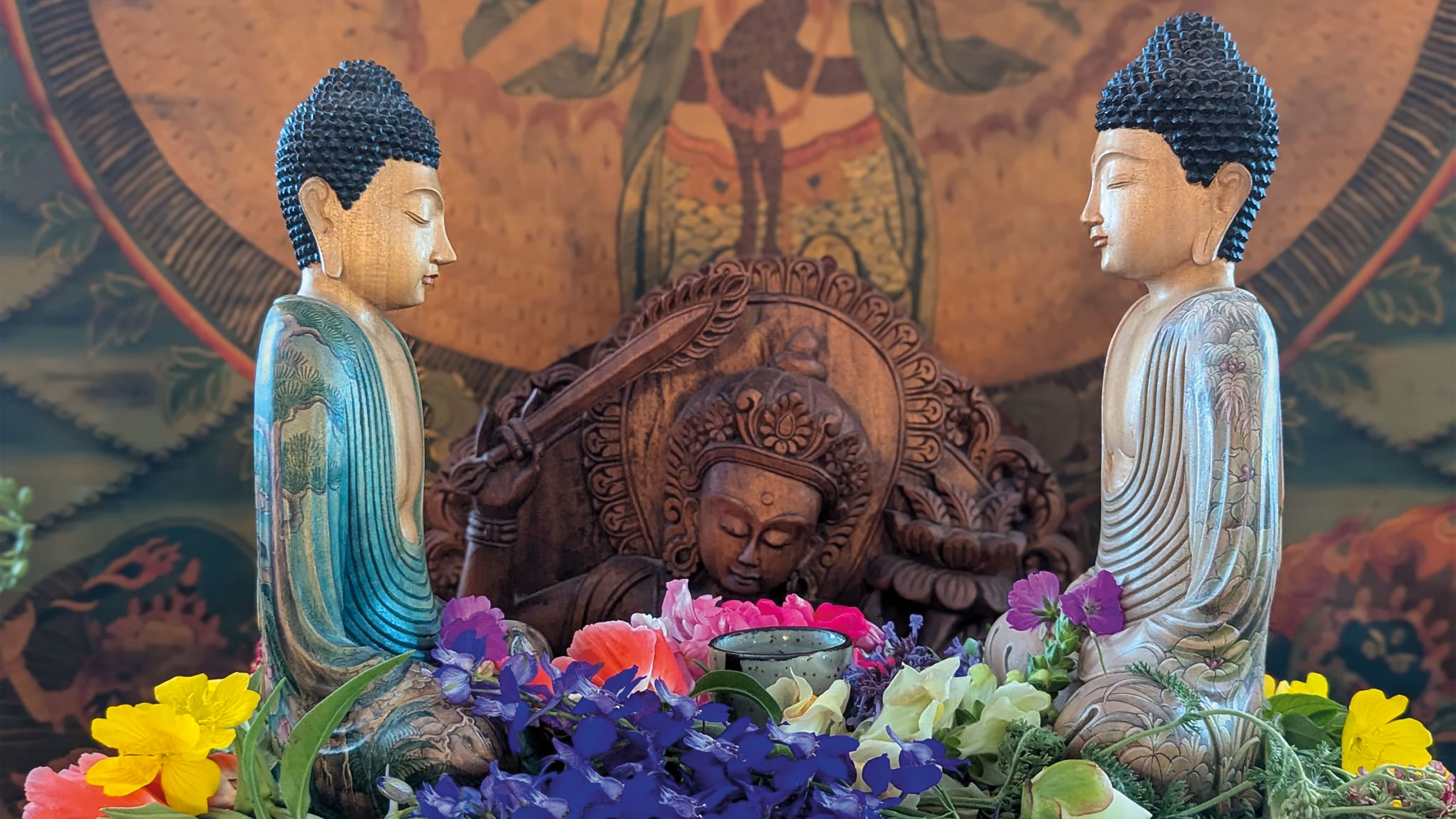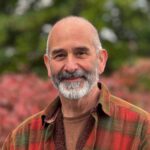On the altar in our zendo, two nearly identical buddha statues sit facing one another. Their faces are calm and open. Their robes fall low, exposing their chests—heart to heart. Painted across their backs and shoulders are scenes from the natural world: trees, birds, animals, water, clouds. They are wrapped in the whole abundant world. Their posture is strong but at ease. Their hearts are uncovered.
They sit together, steady and present. Neither is higher or lower. No one is teaching. No one is fixing anything. Just two buddhas meeting. Face to face. True mind to true mind.
I stumbled into this altar setup one morning a few years ago. Until that day, I’d been arranging the buddha statues on our altar sitting back-to-back—facing outward, meeting the world. That image of outward orientation felt important to us at Bread Loaf Mountain Zen Community, as we practice what I call “Community-Engaged Zen.” We try to let all parts of the community not just into our hearts and minds, but onto the temple grounds and into our lives—inviting people in, welcoming them to make themselves at home, no matter who they are, what they believe, what state they’re in, or what they’re going through.
But on this particular morning, the news had just come in that another war had broken out—sadly, I can’t even remember now if it was Ukraine or Gaza. The headlines were full of heart-wrenching stories: families and communities disrupted, destroyed. So much fear. So much violence. And beneath it all, something heavier—despair.
I walked into the zendo feeling gutted by it. And questions rose up: What’s our practice for? What does it really ask of us in a world on fire?
At the altar, I turned the buddhas toward each other. As I did, I said to the sangha, “If our practice doesn’t teach us how to look each other in the face, to really see one another’s humanity, to see one another as buddha, and to live like we actually depend on one another—then I don’t know what we’re doing here.”
Since that morning, we’ve kept the buddhas facing each other. Every day, they sit as a quiet reminder of what holds our practice together. A reminder to keep looking at each other, seeing each other, bowing to each other. To stay in relationship. To meet the world—not abstractly or occasionally, but continuously, in close proximity to each other’s humanity and the realities of each other’s lives.
That closeness—that vow to stay face to face—isn’t just for our personal relationships. It’s a way of showing up in the world itself. The world as it actually is, even in the hardest places.
Our altar is a vow to enter the hell realms, the cracks of society. Right now, the world is burning. There are horrible, complicated wars. Families are being starved, bombed, and disappeared. Children in Africa are dying because the U.S. government cut off HIV medication programs and other forms of aid—deliberate choices made by people in power who will never meet the children they’ve condemned. People are being vanished into cages without due process and sent to horrific, gulag-like prisons in El Salvador—under a secretive agreement with the U.S. government, far outside the protections of the U.S. Constitution. Meanwhile, free speech is being threatened and punished in open defiance of the First Amendment—the very rights this country claims as its foundation.
These are situations the buddhas and bodhisattvas never turn away from. They don’t turn away from the victims, nor do they turn away from the perpetrators; they don’t turn away from the anonymous systems that we’re all participating in, whether we like it or not. The buddhas meet it all, face to face. So, what does it mean to keep practicing in the middle of this? What does it mean to say, “Buddha bows to buddha”—not as a Hallmark koan, but as a radical act of resistance to the logic of dehumanization?
At times like these, I think of how in the Vimalakirti Sutra, the bodhisattva Manjushri is asked, “Where do you go to practice?” and he answers, “I practice in the world of suffering.” The bodhisattva chooses to enter the marketplaces, the prisons, the sickbeds, the hungry ghost realms, the halls of power—and this isn’t because it’s noble. It’s because liberation happens not after suffering is resolved, but in suffering.
Dogen said it this way: “The entire universe is the true human body.” This means there’s no outside. No pure space untouched by the suffering of others. No temple that exists apart from blood and breath and relationship.
The late Zen teacher Bernie Glassman would call this bearing witness, that is, not standing back and observing suffering from a distance, but allowing yourself to be touched by it. Changed by it. To stop pretending you’re separate from the harm—or from the possibility of healing.
At Bread Loaf Mountain, this is the shape our practice takes at the local level: Gather, our drop-in center, or “community living room,” is a place where people show up who’ve fallen through the cracks—of housing systems, recovery programs, parole conditions, or simply the emotional weight of being alive and alone. Some are sleeping rough. Some are coming out of incarceration. Some are navigating mental illness, grief, addiction, or just exhaustion. Most are longing for a caring and humanizing connection as medicine for the deep loneliness they feel. They come not for fixing, but to be met.
The Grove, our supported transitional housing apartment complex right next door, offers housing for people trying to build a new life—people often served by case managers, probation officers, and clinicians who are doing their best inside systems that are overburdened and under-resourced. We’re not here to criticize those systems. We’re here to work alongside them, bringing different kinds of resources into the room: human presence, ethical clarity, the willingness to sit with someone and not look away.
In the physical space between Gather and The Grove is our No Barriers meditation hall, where these two buddhas sit face to face on the altar. William Butler Yeats famously wrote, “Things fall apart; the center cannot hold.” And it’s true—things do fall apart. We fall apart. The world breaks down. But maybe the center can hold. Our two buddhas, turned toward each other, sit right at the center—holding it all.
When we say, “Buddha recognizes buddha; buddha bows to buddha,” it’s not another ideology. It’s a deep, embodied offering to meet each person face to face, and to walk into even the hardest situations with compassion alive in us.
In my experience, the longer I practice in these settings, the more I see that awakening doesn’t happen through distance or detachment. It happens through ongoing relationship. Through eye contact—again and again. Through story. Through shared silence. Through meals and coffee, through activism and the use of my voice, and through using that voice on behalf of those who don’t always get heard.
It happens by staying close to each other’s pain, without rushing to resolve it and without turning away when the path is long and uncertain. It’s the same as our meditation practice: one step, one breath at a time. We don’t fix and we don’t flee. We stay.
And we let the relationship lead us—slowly, sometimes haltingly—toward wise compassion. That’s what the altar teaches. That’s what the two buddhas, face to face, are modeling every day. They remind us: We don’t get to choose whether or not we’re interconnected—we already are. The question is whether we will live like it. Whether we’ll look at one another across the great divides of this world and say, I see you. I will stay with you. You are buddha, too. And I will meet you here.
And maybe that’s where practice begins—not in silence or stillness alone, but in the choice to turn toward each other. Again and again. In war zones and zendo halls, in courtrooms and coffee shops, in shelters and on sidewalks. Face to face. Heart to heart. Buddha to buddha.

